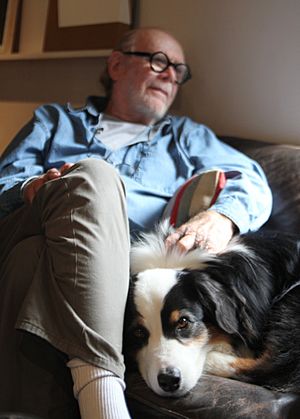Tony DeLap facts for kids
Tony DeLap (born November 4, 1927 – died May 29, 2019) was an American artist. He was famous for his unique sculptures. These sculptures often played tricks on your eyes, making you see things differently.
DeLap was a leader in two art styles: minimalism and Op Art. He always wanted to make people think about what they were seeing. His art showed how he kept pushing the limits of what art could be.
Contents
Tony DeLap's Early Life and Art
Tony DeLap was born in Oakland, California, in 1927. He grew up in the Bay Area. He studied art, illustration, and graphic design at several colleges there. These included the San Francisco Academy of Art. He also studied in Southern California at the Claremont Colleges.
After his studies, DeLap went back to the Bay Area. He taught art at places like the California College of Arts and Crafts. He also taught at the San Francisco Art Institute and UC Davis. Later, he got a teaching job at the new University of California, Irvine. Some famous artists, like Bruce Nauman and James Turrell, were his students.
Art Styles: Geometric Abstraction and Minimalism
DeLap followed art styles called Geometric abstraction and Minimal art. These styles used simple shapes and limited colors. Artists like Ellsworth Kelly also worked in these styles. DeLap's art was very precise and well-made.
In the early 1960s, DeLap became part of a new art movement. It was called West Coast minimalism. Other artists in this group included Craig Kauffman and Larry Bell. They focused on simple, clean art.
Tony DeLap's Art Career
Tony DeLap's artwork was shown in many places. His art was displayed in the United States and other countries. He had many shows where only his art was featured. He was also part of important group shows in the 1960s.
Some of these famous shows included Primary Structures at the Jewish Museum. His work was also in American Sculpture of the Sixties at the Los Angeles County Museum of Art. Another big show was The Responsive Eye at The Museum of Modern Art in New York City.
Tony DeLap passed away on May 29, 2019. He was 91 years old.
Where to See DeLap's Art
Tony DeLap's art is kept in many places. You can find his work in private collections. It is also in many public art museums.
Some of these museums include the San Jose Museum of Art and the Los Angeles County Museum of Art. His art is also at the San Francisco Museum of Modern Art. In New York, you can see his work at the Whitney Museum of American Art and The Museum of Modern Art. The Solomon R. Guggenheim Museum also has his pieces.
Outside the U.S., his art is in The Tate Gallery in London.
Images for kids



